Acting may look like magic from the audience, yet behind every “overnight success” lies a disciplined artist who treats the profession as a lifelong apprenticeship.
Whether you dream of Broadway, independent film, voice‑over booths, or immersive VR performances yet to be invented, the fundamentals remain the same: master your craft, understand the business, and cultivate the right mindset.
This guide weaves those strands together, offering a blueprint you can revisit at every stage of your career.
1 Foundations of the Craft
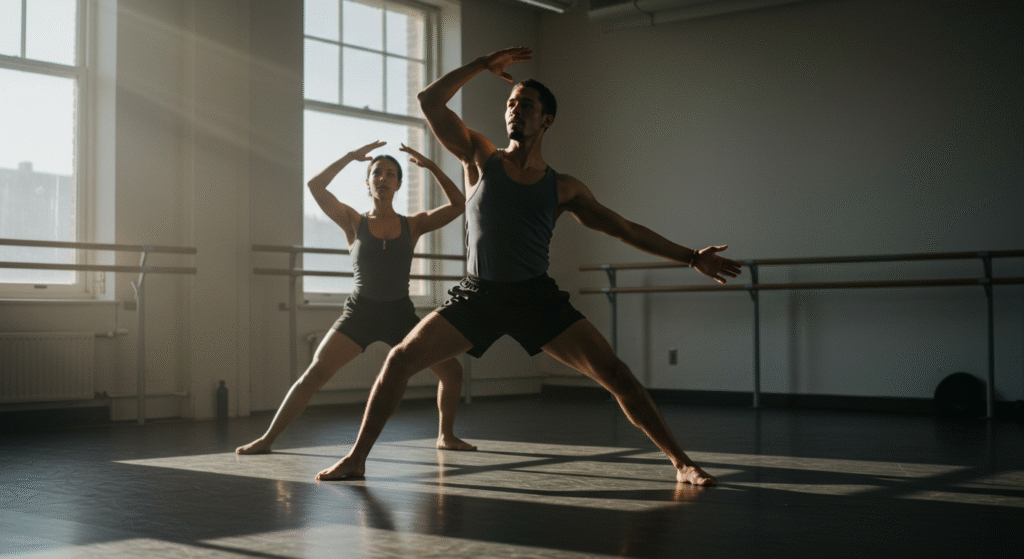
Acting begins with the body and the voice—the instruments through which imagination becomes visible and audible. Before you audition, market yourself, or negotiate contracts, you need control, flexibility, and stamina.
Your body is your first canvas. Everything from posture to micro‑gestures communicates subtext long before words reach an audience.
Daily practices such as Alexander Technique, Pilates, or stage combat sharpen kinesthetic awareness so that choices read clearly in a 1,000‑seat theater and on a tight camera close‑up alike.
Equally important is vocal freedom: from Shakespeare’s iambic pentameter to cinéma‑vérité whispers, actors must scale volume and texture without fatigue. Linklater, Fitzmaurice, and classical singing exercises expand resonance, pitch range, and diction while maintaining authenticity.
Yet neither physical nor vocal mastery happens in a vacuum. Integrating the two—allowing breath to ground emotion, letting movement shape vocal color—creates performances that feel alive rather than “performed.” Begin each rehearsal with an integrated warm‑up that connects spine, diaphragm, and imagination; you’ll find that truthful impulses travel through a relaxed body faster than intellectual decisions can keep up.
Takeaways
- Practice deliberate “body scans”: release shoulder, jaw, and hip tension before rehearsals.
- Adopt a breath‑centered warm‑up: nasal inhale, rib‑cage expansion, voiced exhale on a gentle “zzzz,” 5 minutes.
- Record and review: phone audio captures subtle vocal habits—glottal attacks, swallowed vowels—that audiences notice.
- Cross‑train: yoga for flexibility, dance for rhythm, martial arts for focus under pressure.
2 Techniques & Methodologies
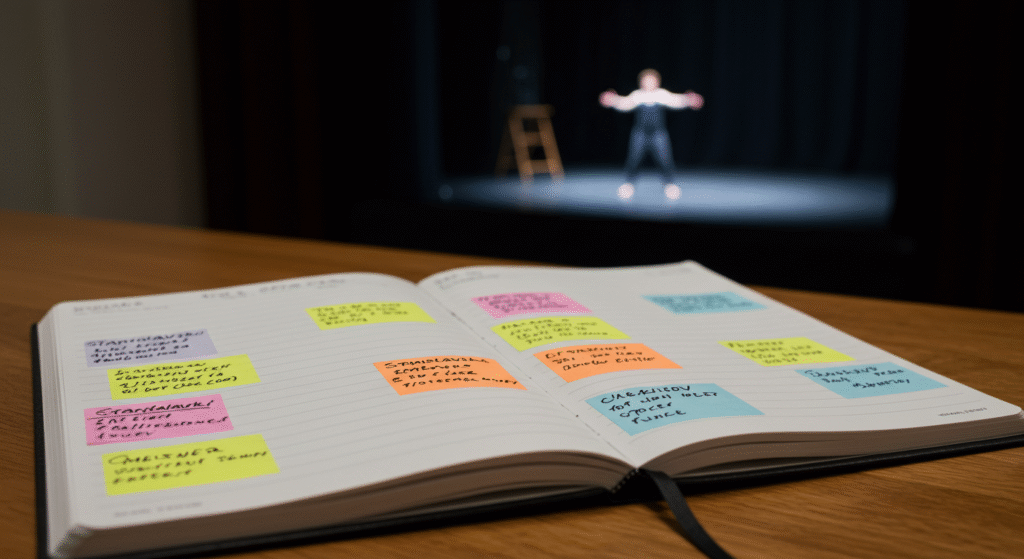
Technique is a toolbox, not a straitjacket. Great actors borrow, remix, and discard methods to suit each role, director, and medium.
Across the 20th century, practitioners from Stanislavski to Anne Bogart crafted exercises that bring characters to life. Stanislavski’s “given circumstances” teach you to uncover a character’s objectives, obstacles, and tactics through logical questions; Meisner’s repetition energizes listening; Chekhov’s psychological gesture channels emotion through stylized movement; Adler emphasizes imagination over emotional memory. Each provides a route into character, but none owns the monopoly on truth.
Exploring multiple approaches prevents creative ruts and prepares you for directors who reference any (or none) of them. More importantly, technique provides repeatability. On set, you might shoot scene 36 ten times out of order; a reliable process guarantees freshness when the camera finally rolls. By constructing a personal methodology—an “operating system” drawn from several schools—you ensure adaptability without losing authenticity.
Takeaways
- Build a personal glossary: keep a notebook summarizing each exercise, trigger, or visualization that worked.
- Bridge theory and practice: assign yourself “homework roles” outside your casting type to stress‑test techniques.
- Avoid dogma: if an exercise feels forced, adapt it—technique should liberate, not constrict.
- Schedule periodic “return to basics” weeks to revisit sensory and viewpoint exercises you risk neglecting.
3 Building a Versatile Skill Set
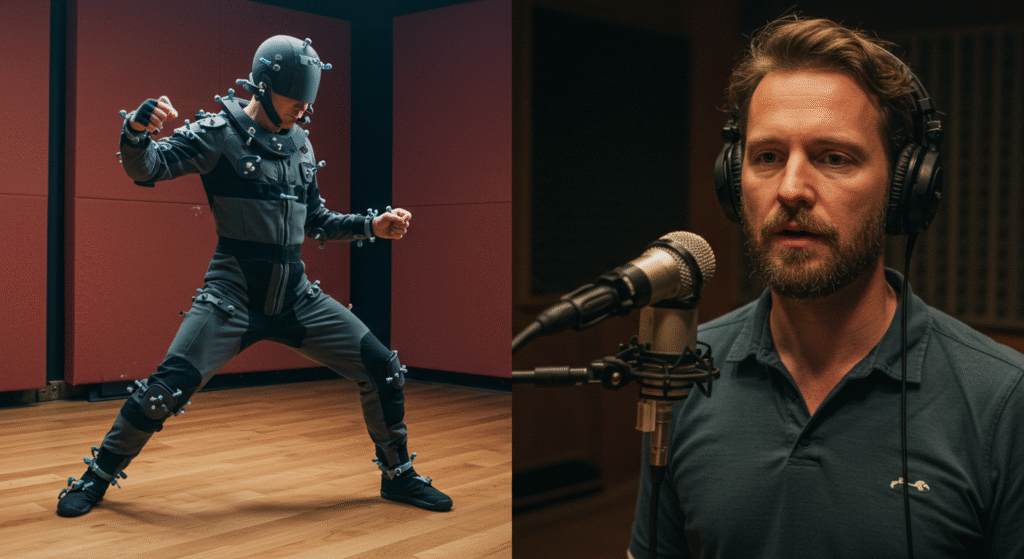
Casting today spans live theatre, streaming series, motion‑capture, dubbing, audiobooks, and interactive games. Versatility is employability.
Directors want collaborators who can pivot from a Jacobean court to a cyberpunk dystopia without months of retraining. That agility begins with movement literacy—Laban effort shapes, Viewpoints compositional tools, dance basics, and intimacy choreography help you hit marks with emotional specificity. Complement movement with vocal versatility: accents, creature voices, commercial clarity. Musicianship, basic dance, or American Sign Language deepen your creative palette and make résumés pop.
The objective isn’t mastery of everything but sufficient proficiency to collaborate without slowing production. A stunt coordinator can refine a competent stage‑combat swing; a dialect coach can polish a passable Irish brogue. Arrive with foundations laid, and specialists elevate you rather than rescue you.
Takeaways
- Curate a “special skills” column: list only abilities you can demonstrate convincingly—casting directors test claims.
- Rotate classes: enroll in a new discipline each quarter (e.g., Stage Combat → Tap Dance → Dialect Coaching).
- Use micro‑practice: five‑minute accent drills while commuting, finger‑tut sequences during breaks.
- Document progress: demo reels with contrasting clips (dramatic monologue, comedic banter, video‑game barks) show range.
4 The Business of Acting
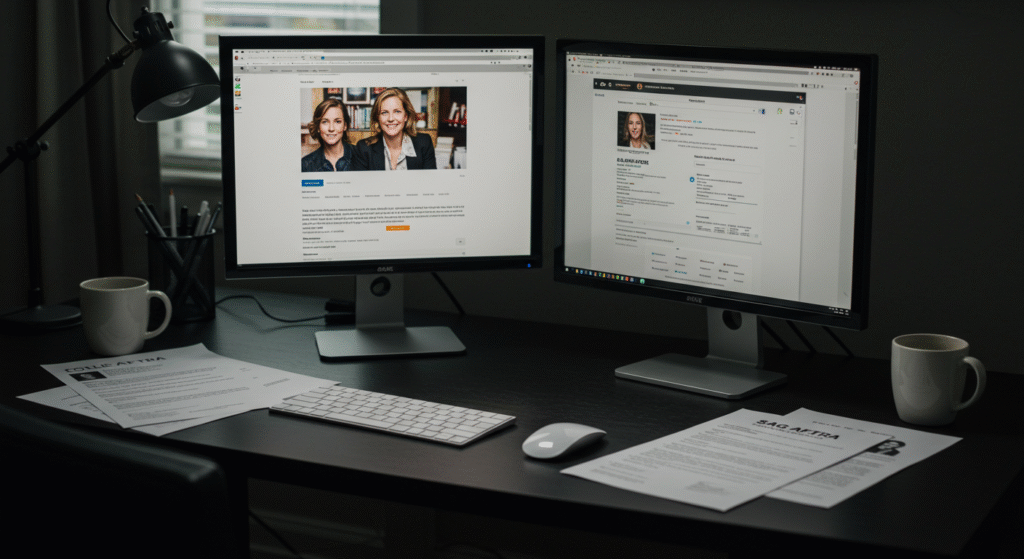
Talent opens doors; business acumen keeps them open. Agents, unions, contracts, and branding determine which opportunities you even hear about.
Actors often shy from the commercial side, fearing it cheapens artistry. In reality, business knowledge protects freedom: an actor who negotiates fairly, files taxes correctly, and markets strategically can afford to take artistic risks. Begin by clarifying your type and brand—the unique slice of humanity you reliably portray and sell. A crisp logline (“warm but wily mentor,” “sharp‑tongued idealist”) guides headshot style, résumé layout, and social media presence.
Next, build relationships: industry mixers, play readings, online casting platforms, and polite follow‑ups form a professional network. Finally, understand the paperwork: SAG‑AFTRA eligibility, equity contracts, usage fees, self‑employment taxes, and intellectual‑property clauses. Ignorance costs money and momentum; fluency turns chaos into choices.
Takeaways
- Audit your digital footprint: search your name; ensure first‑page results reinforce your actor brand.
- Track expenses and income: accounting apps simplify quarterly tax estimates and deductible write‑offs.
- Read every contract aloud; confusing clauses often reveal themselves when spoken.
- Join professional groups: unions, local film alliances, and alumni boards circulate auditions before public release.
5 Mindset & Resilience

Rejection is routine, comparison is constant, and career timelines are unpredictable. A resilient mindset is non‑negotiable.
Psychologists call acting one of the world’s most rejection‑dense professions. Auditions reflect fit, timing, and market trends more than intrinsic talent, yet our brains translate “no” as personal failure. The antidote is process focus—measuring progress by actions under your control (preparation quality, number of submissions) rather than outcomes.
Add mental hygiene: mindfulness meditation, cognitive reframing, or journaling reduces rumination. Cultivate passions outside acting—whether baking sourdough or volunteering with animal rescues—to protect joy from box‑office results. Finally, build a support system of peers who celebrate call‑backs and commiserate on near‑misses without toxic competitiveness. Success becomes sustainable when the journey itself feels meaningful.
Takeaways
- Adopt a post‑audition ritual: brief reflection, actionable note, then a physical “shake‑off” to reset.
- Set process‑oriented goals (“submit 10 self‑tapes this month”) instead of outcome goals (“book a lead”).
- Use gratitude lists: record three non‑career wins each day to balance perspective.
- Invest in therapy or coaching before crises—preventive care beats emergency repair.
6 Training & Continuous Learning
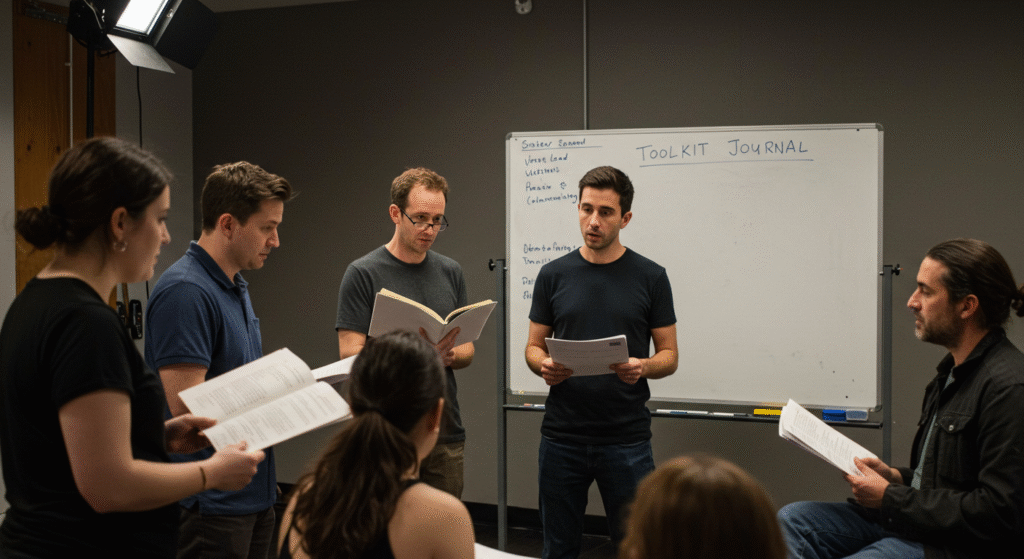
Acting is a perishable skill. Even seasoned performers schedule class days to stretch beyond comfort zones.
Choose training like a portfolio: combine foundational classes (scene study, voice) with special‑topic intensives (clown, motion‑capture). Seek teachers who challenge assumptions yet respect individual process; audit sessions when possible. Beyond formal classes, self‑education via reading plays, watching international cinema, and analyzing performances keeps artistry evolving.
Record rehearsals, solicit feedback, and iterate—growth thrives on constructive critique. Treat each project as a laboratory: note what worked, what stalled, and which exercises unlocked breakthroughs. Over years, this habit builds an internal syllabus tailored to your strengths and blind spots.
Takeaways
- Budget for education: allocate a fixed percentage of annual income to classes and workshops.
- Create peer labs: weekly meet‑ups to cold‑read new material cost nothing and hone instincts.
- Diversify instructors to avoid adopting one school’s blind spots.
- Document learnings: maintain a “toolkit journal” summarizing insights and exercises for quick refreshers.
7 Auditioning Mastery
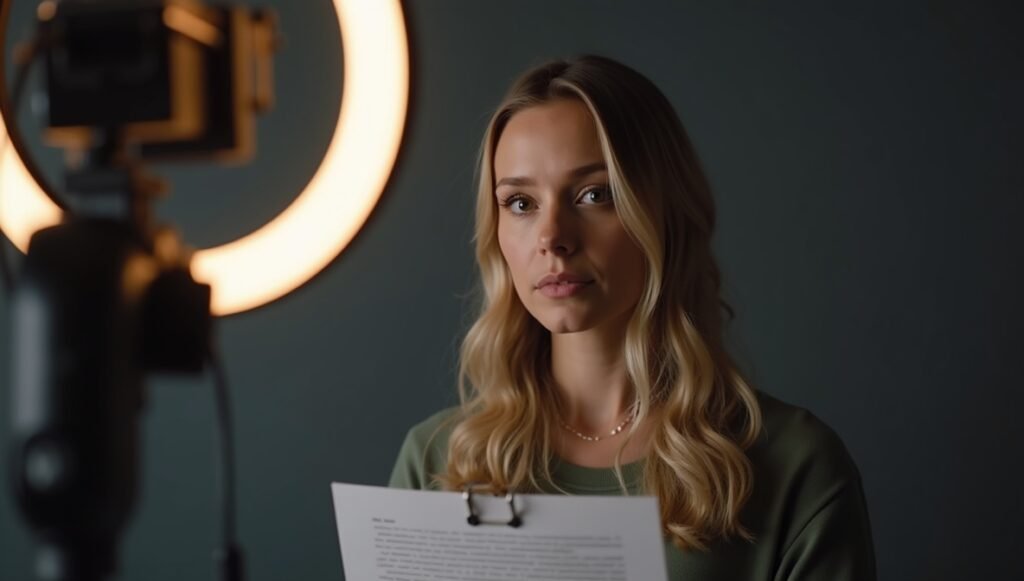
Auditions are performances in miniature, demanding spontaneity within rigid constraints.
Preparation starts with rapid text analysis: identify objective, playable action, and pivot beats. Next, design choices that are bold yet adjustable—directors value actors who can pivot in the room. Technical details matter: lighting and sound for self‑tapes, comfort with reader lag, slating that conveys personality without gimmick.
Above all, professionalism—punctuality, memorization, and gratitude—signals reliability. An actor who arrives camera‑ready saves time and budget, making casting eager to work with them again. Approach every audition as relationship‑building, not a lottery ticket.
Takeaways
- Mark script beats in contrasting colors to visualize rhythm.
- Rehearse redirection: ask friends to throw curveball adjustments so flexibility feels normal.
- Set self‑tape templates: consistent backdrop, ¾ framing, soft fill light, lav mic for clarity.
- Follow naming conventions: files labeled “Lastname_Firstname_Role_Project” help casting track you.
8 Career Strategy & Goal Setting
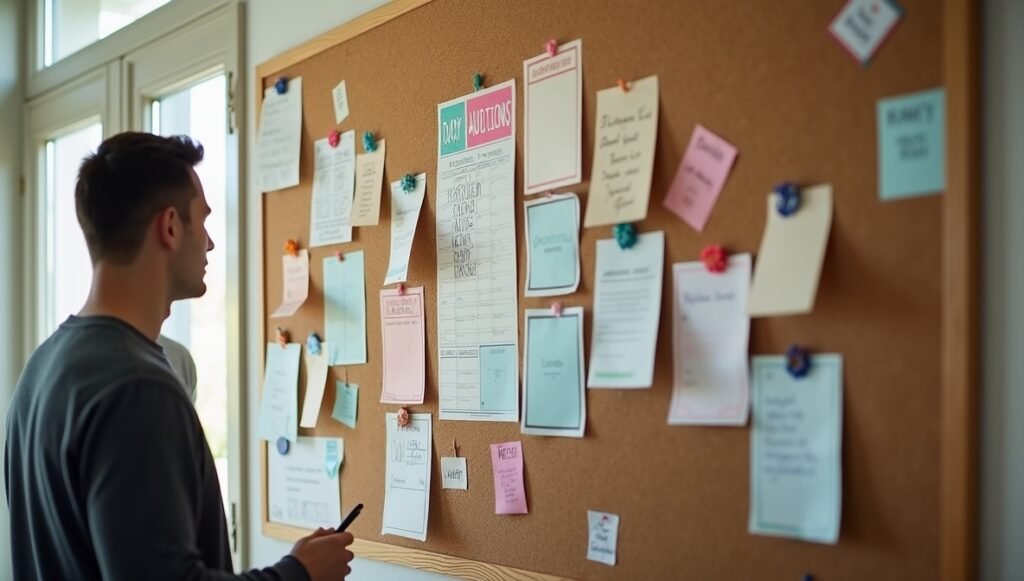
An acting career is a marathon with detours, not a linear sprint. Strategic planning turns hopes into maps.
Start by defining a long‑range vision: Where do you want to be in five and ten years? Break that into yearly milestones (e.g., union membership, first network credit, regional theatre lead). Align each quarter’s actions—classes, showcases, submissions—with those milestones.
Track metrics: auditions, callbacks, bookings, income streams. Regular reviews identify patterns, reveal bottlenecks, and celebrate incremental wins that might otherwise blur. A written plan transforms abstract dreams into tangible stepping‑stones.
Takeaways
- Use SMART goals (specific, measurable, achievable, relevant, time‑bound) for clarity.
- Diversify income: teaching, audiobook narration, or corporate training can finance passion projects without side‑tracking you.
- Schedule quarterly “career retreats”—half‑day reflection with agendas, data review, and next‑step planning.
- Adapt goals: industries shift; updating plans is a sign of agility, not failure.
Conclusion:
The art of acting isn’t one discipline; it’s an ecosystem. Your craft supplies truth, your business savvy sustains opportunity, and your mindset fuels longevity. Neglect any element, and the structure tilts. Nurture each with curiosity and rigor, and you’ll navigate an ever‑changing industry while keeping creativity alive. Treat this guide as a living document: revisit, revise, and annotate it as your experience deepens. Above all, remember why you started—storytelling is humanity’s oldest bridge, and actors keep that bridge open.
Summary Table
| Aspect | Core Focus | Practical Actions |
|---|---|---|
| Foundations of the Craft | Physical and vocal mastery | Daily integrated warm‑ups, body scans, breath work |
| Techniques & Methodologies | Diverse acting methods | Build personal glossary, stress‑test techniques |
| Versatile Skill Set | Movement & voice versatility | Rotate classes, practice accents, compile demo reels |
| Business of Acting | Branding, networking, contracts | Audit online presence, read contracts aloud |
| Mindset & Resilience | Mental health & process focus | Post‑audition ritual, gratitude lists, therapy |
| Continuous Learning | Ongoing education | Budget for workshops, create peer labs |
| Auditioning Mastery | Efficient, adaptable auditions | Beat mapping, self‑tape standards, naming conventions |
| Career Strategy | Long‑term planning | SMART goals, data reviews, quarterly retreats |

